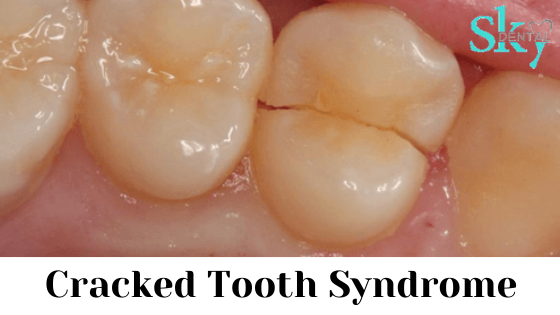Cracked Tooth Syndrome is where a tooth is incompletely cracked. It could also be considered as a type of Dental trauma. If a person experiences pain while chewing, or if a sudden feeling of sensitivity to hot or cold, one tooth may be cracked. A cracked tooth can result from chewing hard foods, grinding teeth at night and also occurs naturally with your age.
Teeth with cracked tooth syndrome usually have fractures that are too small and invisible to the naked eye. In some cases, the fracture is below the gumline which is even more difficult to identify. And the pain associated with cracked tooth tends to come frequently. This is more challenging for a dentist to locate the crack especially when it is very small.
Symptoms of Cracked tooth syndrome
Most of the people may experience cracked tooth syndrome as pain or discomfort when you chew or bite food. And also, when teeth are exposed to cold or hot temperatures. However, this pain is not constant. This pain occurs only when you eat certain foods or bite in a specific way. If it is left untreated, the crack may become worse and leads to tooth loss.
- Pain when you are chewing or biting, especially the harder food items.
- Suddenly becomes sensitive to sweetness, hot or cold.
- Rarely continuous pain that tends to come and go.
- Swelling of the gum around the cracked tooth.
- Discomfort or pain around the gums and teeth which is hard to identify.
What are the causes of a tooth to crack?
There are many different reasons that cause a cracked tooth. Some of the causes include:
- Excessive pressure from grinding of the teeth.
- Chewing or biting the hard foods that are hot, cold and sugary.
- The physical injury which might happen due to accident, sporting injury or fall.
- Cracks can also occur according to age.
- Fillings which are so large can also weaken the rest of the tooth structure.
How to Diagnose the cracked tooth syndrome?
Diagnosis of a cracked tooth syndrome is not that easy. Your dentist will probably undergo
- If the crack is not visible, your dentist may diagnosis based on the dental history of the patient, such as whether you chew on hard foods.
- You dentist may undergo the visual examination of the teeth and complete mouth using a magnifying lens to find the minor cracks which are invisible for the naked eye.
- They may also run a dental explorer to catch on any rough, cracked edges on the teeth’s surface.
- A dental dye is also used to make the crack visible.
- The dentist may also undergo the examination of gums to look for inflammation. Because the cracked teeth tend to irritate the gums.
- The X-ray also takes place during the process of diagnosis of cracked tooth syndrome. However, X-ray won’t reveal the crack. But it points out the poor pulp health of the teeth which indicates the presence of a crack.
Treatment for a cracked tooth
However, the treatment of the cracked tooth does not relieve the symptoms. Treatments depend on the location and extent of the teeth. Based on these factors your dentist may recommend one of the following treatments
Bonding: Here your dentist uses a plastic resin to fill the crack. Along with regaining its look and function.
Crown: This fits over the damaged tooth which is usually made of porcelain or ceramic. In this procedure, your dentist initially shaves the enamel of the tooth in order to make the space. And then they make an impression of the tooth, pick out a colour that matches your teeth and sends to the lab.
Root Canal: The extension of the crack may go wrong into the pulp. Your dentist or endodontist will recommend a root canal to remove the damaged pulp and also restores integrity to the tooth. The prevents the teeth from further infection.
Extraction: In the case of the structure of the tooth and roots got damaged, removing the tooth may be the only option.



Nice article, would like to do that too!